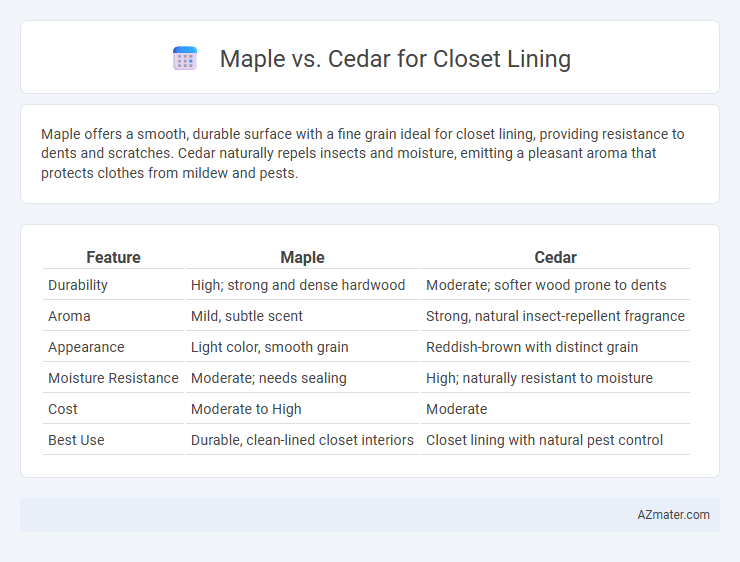Maple offers a smooth, durable surface with a fine grain ideal for closet lining, providing resistance to dents and scratches. Cedar naturally repels insects and moisture, emitting a pleasant aroma that protects clothes from mildew and pests.
Table of Comparison
| Feature | Maple | Cedar |
|---|---|---|
| Durability | High; strong and dense hardwood | Moderate; softer wood prone to dents |
| Aroma | Mild, subtle scent | Strong, natural insect-repellent fragrance |
| Appearance | Light color, smooth grain | Reddish-brown with distinct grain |
| Moisture Resistance | Moderate; needs sealing | High; naturally resistant to moisture |
| Cost | Moderate to High | Moderate |
| Best Use | Durable, clean-lined closet interiors | Closet lining with natural pest control |
Introduction to Closet Lining Woods
Maple and cedar are popular choices for closet lining woods due to their distinct properties and benefits. Maple offers a smooth, hard surface that resists dents and scratches while providing a clean, bright appearance. Cedar naturally repels insects and absorbs moisture, making it ideal for preserving clothing and preventing mold.
Maple vs Cedar: Overview
Maple offers a smooth, durable surface with a light, consistent grain ideal for closet lining, while cedar provides natural aromatic properties and insect resistance that protect clothing from moths and moisture. Maple's fine texture and hardness make it less prone to dents and scratches, ensuring long-lasting structural integrity. Cedar's natural oils combat mold and mildew, creating a fresh environment that extends garment lifespan.
Appearance and Aesthetic Appeal
Maple closet lining features a smooth, fine grain with a light, creamy color that provides a clean and modern aesthetic, enhancing the brightness of closet interiors. Cedar, known for its rich reddish-brown hue and distinctive aromatic properties, adds a warm, rustic charm while naturally repelling insects and mildew. Both woods offer unique visual appeal, with maple suited for contemporary designs and cedar preferred for traditional or nature-inspired closet spaces.
Durability and Longevity
Maple offers superior durability for closet lining due to its dense grain structure, which resists dents and scratches over time. Cedar, while slightly softer, provides natural resistance to moisture and insects, enhancing longevity in humid environments. Choosing between maple and cedar depends on the balance of physical hardness versus natural preservative qualities for your closet space.
Aroma and Natural Scent
Maple closet lining offers a subtle, sweet aroma that gently enhances the space without overwhelming, making it ideal for those seeking a mild, natural scent. Cedar excels with a strong, distinctive fragrance rich in natural oils that act as a powerful moth and insect repellent, preserving garments effectively. The aromatic intensity of cedar makes it the preferred choice for closet lining where scent and protection against pests are priorities.
Moisture and Pest Resistance
Maple offers moderate moisture resistance, making it suitable for closets in generally dry environments but may require sealing in humid conditions. Cedar excels in moisture resistance due to its natural oils, which also repel insects like moths and termites, providing superior pest protection. This makes cedar an ideal choice for closet lining where both moisture and pest resistance are critical factors.
Maintenance and Care
Maple closet lining offers a smooth, tightly-grained surface that resists dirt and requires minimal maintenance with occasional dusting and gentle cleaning using mild soap and water. Cedar, known for its natural oils, provides insect-repellent properties but demands periodic airing to prevent moisture buildup and maintain its aromatic qualities. Both woods benefit from avoiding harsh chemicals to preserve their appearance and longevity in closet environments.
Cost Comparison
Maple closet lining typically costs between $4 to $8 per square foot, offering a durable and smooth finish that justifies its mid-range price. Cedar, priced higher at $6 to $12 per square foot, provides natural aromatic properties and insect resistance, adding value through functionality rather than just appearance. Choosing between maple and cedar depends on budget constraints and desired benefits like scent and pest deterrence.
Environmental Impact
Maple for closet lining offers a sustainable choice due to its fast growth rate and abundance, resulting in lower deforestation impact. Cedar, while prized for its natural resistance to moisture and pests, often involves harvesting from older, slower-growing trees, which can contribute to habitat disruption. Selecting FSC-certified maple or cedar ensures responsible forestry practices, promoting biodiversity and reducing carbon footprint.
Which Wood Is Best for Your Closet?
Maple offers a smooth, durable surface with a light, consistent grain ideal for closet lining, providing resistance to dents and scratches. Cedar is prized for its natural aromatic properties and insect-repellent qualities, making it a preferred choice for protecting clothing from moths and moisture. Choosing the best wood depends on whether durability and appearance (Maple) or natural preservation and fragrance (Cedar) are top priorities for your closet.

Infographic: Maple vs Cedar for Closet Lining
 azmater.com
azmater.com